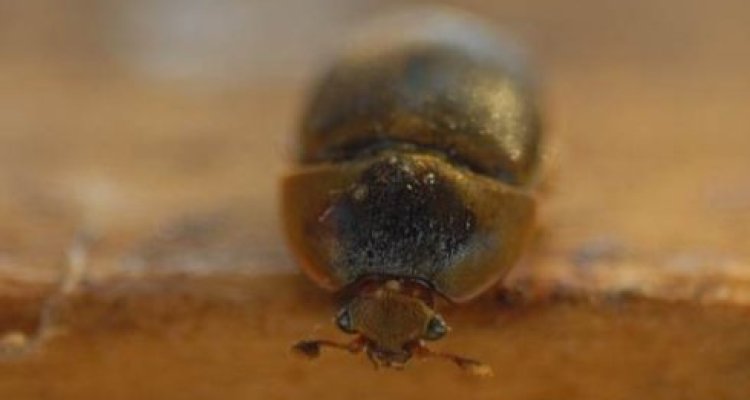
Small Hive Beetle
The Small Hive Beetle (SHB, Aethina tumida) has recently been introduced in Southern Italy in the province of Calabria. This species, new to Europe, parasitizes bee colonies with damaging effects.
The Small Hive Beetles was first reported in Italy on September 5th of 2014. In three small nuclei larvae as well as adults were found. The Italian national reference lab on bee diseases (NRL-IZS delle Venezie, Padua) later confirmed the identity of the specimen found. So far the outbreaks has led to 59 confirmed finds of Small Hive Beetle larvae and/or adults at local apiaries a one find on the island of Sicily (Dec 2014). As the beetle is able to survive the climatic conditions of the United States and Canada, it is likely to become established in most parts of Europe.
Beetle Biology
The small Hive Beetle (Aethina tumida) originates from Sub-Saharan Africa. Within its natural range it’s hardly regarded as a plague, as most honey bee colonies are able to cope with its presence. Only weakened and diseased colonies are susceptible to damage by the beetle. To some extend this is also the case in areas outside of its natural range, such as the United States and Australia. The damage is mainly done by the larvae, which feed on combs and anything found in them. This also means that stored frames can be infected. As larvae feed their way through the combs, they defecate, leaving the remaining honey to yeast. Contaminated honey is unsuitable for consumption.
More information
- Brochure: Aethina tumida – Kleine bijenkastkever, Brochure on the Small Hive Beetle, 2007. Information on biology and natural history (in Dutch)
- Small Hive Beetle Factsheet (931 KB), Factsheet on the identification and biology of Small Hive Beetle, published by the EU Reference Lab Anses
- Managing Small Hive Beetles (pdf) by J. Zawislak, University of Arkansas
- Handbook of Small Hive Beetle IPM (PDF) by M. Hood, Extension Apiculturist at Clemson University, 2011
- Extension.org - Webpage on Managing Small Hive Beetle
- Small hive beetle management options (pdf) by Nicholas Annand, NSW DPI, 2008
Film
Scientific literature and Diagnostic manuals
The small hive beetle is an invasive honey bee pest with a global impact. Knowing how to screen honey bee colonies is key to establish an early notion of its presence in uninvaded areas. Here are some tips on how to find them inside a honey bee colony.
Cornelissen, B., & Neumann, P. (2018). How to Catch a Small Beetle: Top Tips for Visually Screening Honey Bee Colonies for Small Hive Beetles. Bee World, 1-4.
Neumann, P., Evans, J.D., Pettis, J.S., Pirk, C.W.W., Schäfer, M.O., Tanner, G., Ellis, J.D. 2013. Standard methods for small hive beetle research. V. Dietemann; J.D. Ellis, P. Neumann (Eds) The COLOSS BEEBOOK, Volume II: standard methods for Apis mellifera pest and pathogen research. Journal of Apicultural Research, 52(4): 32 pp.
Cuthbertson, A.G.S., Wakefield, M.E., Powell, M.E., Marris, G., Anderson, H., Budge, G.E., Mathers, J.J., Blackburn, L.F., Brown, M.A. 2013. The small hive beetle Aethina tumida: A review of its biology and control measures. Current Zoology 59(5): 644-653.
Neumann, P., Ellis, J.D. 2008. The small hive beetle (Aethina tumida Murray, Coleoptera: Nitidulidae): distribution, biology and control of an invasive species. Journal of Apicultural Research 47(3): 181-183.
Ellis, J.D., Hepburn, H.R. 2006. An ecological digest of the small hive beetle (Aethina tumida), a symbiont in honey bee colonies (Apis mellifera). Insectes Sociaux 53: 8-19.
Ellis, J.D. 2005. Reviewing the confinement of small hive beetles (Aethina tumida) by western honey bees (Apis mellifera). Bee World 86(3): 56-62.
Hood, W.M. 2004. The small hive beetle, Aethina tumida: a review. Bee World 85(3): 51-59.
Neumann, P., Elzen, P.J. 2004. The biology of the small hive beetle (Aethina tumida, Coleoptera: Nitidulidae): Gaps in our knowledge of an invasive species. Apidologie 35(3): 229 – 247.
Hood, W.M. 2000. Overview of the small hive beetle, Aethina tumida, in North America. Bee World 81(3): 129-137.
Anonymous 2013. Small hive beetle infestation (Aethina tumida). In: Volume 1: Manual of Diagnostic Tests and Vaccines for Terrestrial Animals, 7th Ed. 6 pp.
